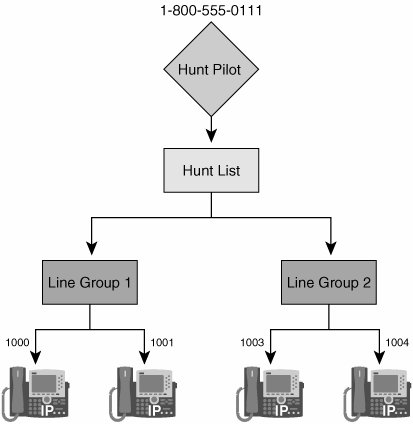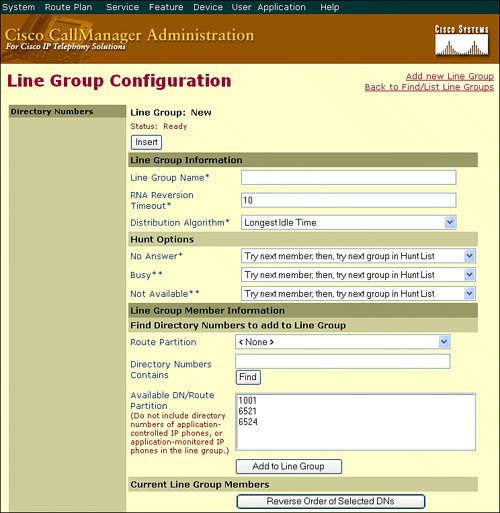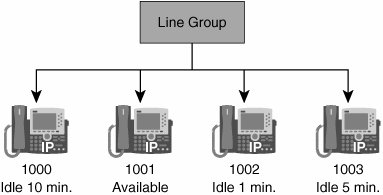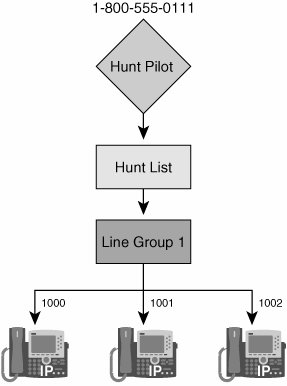Call Distribution Components
Line groups, hunt lists, and hunt pilots work together to provide call-distribution capabilities in Cisco CallManager Administration. Call distribution is the ability of a caller to dial a number and have the call extended in an ordered manner to members of a group. An example of this functionality is a company 800 number to reach a company technical support department.
A line group contains directory numbers (DNs) and designates the order in which DNs are chosen.
A hunt list contains one or more prioritized line groups.
A hunt pilot is a number that is associated with a hunt list. The hunt pilot can be called directly (for example, to a technical support hotline for a company), or can be reached through forwarding (for example, a caller places a direct call to a technical support group member, and if that member is not available, the call is forwarded to the hunt pilot number). Figure 12-1 demonstrates the proper design of the Cisco CallManager call distribution components.
Figure 12-1. Cisco CallManager Call Distribution Components

Line Groups
A line group allows you to designate the distribution mechanism where DNs are chosen.
Line groups contain the following components, shown in Figure 12-2:
- Members Directory numbers that are in one of these states:
- Idle Not serving any call
- Available Serving an active call but able to accept new calls
- Busy Unable to accept any calls
- Distribution Algorithm A method for distributing calls to members.
- Ring No Answer Reversion (RNAR) timeout value A mechanism for determining how to handle calls that go unanswered. The RNAR is a value, in seconds, after which Cisco CallManager will distribute a call to the next available or idle member of this line group or to the next line group if the call is not answered and if the first hunt option, Try Next Member; Then, Try Next Group in Hunt List, is chosen. The RNAR timeout applies at the line-group level to all members.
- Hunt options The ability to roll past members who are busy, not available, or do not answer, continuing until the call is answered or options are exhausted.
Figure 12-2. Line Group Components

Cisco CallManager distributes a call to idle or available members of a line group based on the call-distribution algorithm and on the RNAR setting.
Call-Distribution Algorithms
Line groups contain an algorithm that controls how calls that come in on the hunt pilot are distributed to members, as follows:
- Top down If you choose this distribution algorithm, Cisco CallManager distributes a call to idle or available members starting from the first idle or available member of a line group to the last idle or available member. Referring to Figure 12-3, a top-down distribution algorithm would extend the next call to 1000, then to 1001 (if 1000 was unavailable), then to 1002 (if 1001 was unavailable), then to 1003 (if 1002 was unavailable). The next incoming call would then be sent back to 1000 to start the process over again.
Figure 12-3. Call-Distribution Algorithms

- Circular If you choose this distribution algorithm, Cisco CallManager distributes a call to idle or available members starting from the (n+1)th member of a line group, where the nth member is the last member to receive a call. Because of this, Circular distribution is commonly referred to as round robin. If the nth member is the last member of a line group, Cisco CallManager distributes a call starting from the top of the line group. Referring to Figure 12-3, assume that Cisco CallManager extended the last call to 1002 (n). The next call that comes in on the hunt pilot number would go to 1003 (n + 1).
- Longest idle time If you choose this distribution algorithm, Cisco CallManager distributes a call starting from the member of a line group who has been idle longest to the member who has been idle for the shortest time. Referring to Figure 12-3, assume that 1000 has been idle for 10 minutes and 1003 has been idle for 5 minutes. A longest idle time distribution mechanism would extend the call to 1000, and the next incoming call would go to 1003.
- Broadcast If you choose this distribution algorithm, Cisco CallManager distributes a call to all idle or available members of a line group simultaneously.
Hunt Options
Hunt options configured in the line group apply to members in one of the three states: no answer, busy, or not available. Not available is a state triggered by the Do Not Disturb (DND) line state, covered later in the chapter. For a given distribution algorithm, the hunt option specifies where CallManager should distribute a call next if a member of a line group is busy, does not answer, or is not available. The Line Group Configuration window provides the following options for each of the three hunt options:
- Try Next Member, Then, Try Next Group in Hunt List (Default) Distributes a call to idle or available members. If all lines respond with no answer (or busy or not available), try the next line group in a hunt list.
- Try Next Member, But Do Not Go to Next Group Distributes a call to idle or available members. Stops hunting upon reaching the last member of the current line group.
- Skip Remaining Members, and Go Directly to Next Group Skips the remaining members of current line group when the RNAR timeout value elapses for the first member (or first member is busy or not available). Hunting proceeds to the next line group in a hunt list.
- Stop Hunting Stops hunting after trying to distribute a call to the first member of current line group if the member does not answer (or first busy member or first unavailable member).
Tip
Distributing the call to other line groups can be useful in an environment where you have Tier 1 and Tier 2 tech support. If all the lines in Tier 1 are busy, the call can spill over to the Tier 2 group. In addition, the Tier 2 employees will see the call redirect information so they can answer the call appropriately.
Call Distribution Scenarios: Top-Down Example
Figure 12-4 shows an example of a line group (Line Group 1) with the following setup information:
- Line Group 1 Contains DNs 1000, 1001, and 1002
- Distribution algorithm Top down
- RNAR timeout 10 seconds. After 10 seconds, Cisco CallManager will distribute a call to the next available or idle member of this line group or to the next line group if the call is not answered and if the first hunt option, Try Next Member; Then, Try Next Group in Hunt List, is chosen.
Hunt Options
- RNA Try Next Member; Then, Try Next Group in Hunt List
- Busy Try Next Member; Then, Try Next Group in Hunt List
- Not available Try Next Member; Then, Try Next Group in Hunt List
Figure 12-4. Call Distribution Example

The call flow is as follows:
- Caller calls hunt pilot 1-800-555-0155.
- 1000 rings and is not answered for 10 seconds (RNAR timeout).
- The call extends next to 1001, following the top-down algorithm and RNAR setting.
- 1001 rings for 3 seconds.
- 1001 is answered.
Hunting and Forwarding
Hunting differs from call forwarding, although both allow calls to be redirected. Hunting allows Cisco CallManager to extend a call to one or more lists of numbers, where each such list can specify a hunting order that is chosen from a configurable set of algorithms. When a call extends to a hunt party from these lists and the party fails to answer or is busy, hunting resumes with the next hunt party. (The next hunt party varies depending on the current hunt algorithm.) Hunting thus ignores the Call Forward No Answer (CFNA) or Call Forward Busy (CFB) settings for the attempted party.
Call forwarding allows detailed control as to how to extend (divert and redirect are equivalent terms for extend) a call when a called party fails to answer or is busy and hunting is not taking place. For example, if the CFNA setting for a line is set to a hunt pilot number, an unanswered call to that line diverts to the hunt pilot number and thus begins a hunt.
Starting with Cisco CallManager Release 4.1, Cisco CallManager offers the ability to redirect a call when hunting fails (that is, when hunting terminates without any hunt party answering, either because the list of hunt numbers exhausts or because the hunt process times out). If used, this final redirection constitutes a Call Forwarding action. Therefore, the Hunt Pilot Configuration window in Cisco CallManager Administration (choose Route Plan > Route/Hunt > Hunt Pilot) includes call forwarding configuration concepts that are similar to those found in the Directory Number Configuration window (Forward No Answer/Forward Busy).
In Cisco CallManager Release 4.0, hunting stops either when one of the hunt parties answers the call or when the hunt list is exhausted. When hunting stops due to exhaustion, the caller receives a reorder tone (or an equivalent announcement).
Part I: Cisco CallManager Fundamentals
Introduction to Cisco Unified Communications and Cisco Unified CallManager
Cisco Unified CallManager Clustering and Deployment Options
- Cisco Unified CallManager Clustering and Deployment Options
- The Two Sides of the Cisco Unified CallManager Cluster
- Cluster Redundancy Designs
- Call-Processing Deployment Models
- Summary
- Review Questions
Cisco Unified CallManager Installation and Upgrades
- Cisco Unified CallManager Installation and Upgrades
- Cisco Unified CallManager 4.x Clean Installation Process
- Upgrading Prior Cisco Unified CallManager Versions
- Summary
- Review Questions
Part II: IPT Devices and Users
Cisco IP Phones and Other User Devices
Configuring Cisco Unified CallManager to Support IP Phones
- Configuring Cisco Unified CallManager to Support IP Phones
- Configuring Intracluster IP Phone Communication
- IP Phone Configuration
- Case Study: Device Pool Design
- Summary
- Review Questions
Cisco IP Telephony Users
- Cisco IP Telephony Users
- Cisco CallManager User Database
- Cisco CallManager User Configuration
- User Logon and Device Configuration
- Summary
- Review Questions
Cisco Bulk Administration Tool
- Cisco Bulk Administration Tool
- The Cisco Bulk Administration Tool
- Using the Tool for Auto-Registered Phone Support
- Summary
- Review Questions
Part III: IPT Network Integration and Route Plan
Cisco Catalyst Switches
- Cisco Catalyst Switches
- Catalyst Switch Role in IP Telephony
- Powering the Cisco IP Phone
- Data and Voice VLANs
- Configuring Class of Service
- Summary
- Review Questions
Configuring Cisco Gateways and Trunks
- Configuring Cisco Gateways and Trunks
- Cisco Gateway Concepts
- Configuring Access Gateways
- Cisco Trunk Concepts
- Configuring Intercluster Trunks
- SIP and Cisco CallManager
- Summary
- Review Questions
Cisco Unified CallManager Route Plan Basics
- Cisco Unified CallManager Route Plan Basics
- External Call Routing
- Route Plan Configuration Process
- Summary
- Review Questions
Cisco Unified CallManager Advanced Route Plans
- Cisco Unified CallManager Advanced Route Plans
- Route Filters
- Discard Digit Instructions
- Transformation Masks
- Translation Patterns
- Route Plan Report
- Summary
- Review Questions
Configuring Hunt Groups and Call Coverage
- Configuring Hunt Groups and Call Coverage
- Call Distribution Components
- Configuring Line Groups, Hunt Lists, and Hunt Pilots
- Summary
- Review Questions
Implementing Telephony Call Restrictions and Control
- Implementing Telephony Call Restrictions and Control
- Class of Service Overview
- Partitions and Calling Search Spaces Overview
- Time-of-Day Routing Overview
- Configuring Time-of-Day Routing
- Time-of-Day Routing Usage Scenario
- Summary
- Review Questions
Implementing Multiple-Site Deployments
- Implementing Multiple-Site Deployments
- Call Admission Control
- Survivable Remote Site Telephony
- Summary
- Review Questions
Part IV: VoIP Features
Media Resources
- Media Resources
- Introduction to Media Resources
- Conference Bridge Resources
- Media Termination Point Resources
- Annunciator Resources
- Transcoder Resources
- Music on Hold Resources
- Media Resource Management
- Summary
- Review Questions
Configuring User Features, Part 1
- Configuring User Features, Part 1
- Basic IP Phone Features
- Softkey Templates
- Enhanced IP Phone Features
- Barge and Privacy
- IP Phone Services
- Summary
- Review Questions
Configuring User Features, Part 2
- Configuring User Features, Part 2
- Cisco CallManager Extension Mobility
- Client Matter Codes and Forced Authentication Codes
- Call Display Restrictions
- Malicious Call Identification
- Multilevel Precedence and Preemption
- Summary
- Review Questions
Configuring Cisco Unified CallManager Attendant Console
- Configuring Cisco Unified CallManager Attendant Console
- Introduction to Cisco CallManager Attendant Console
- Call Routing and Call Queuing
- Server and Administration Configuration
- Cisco Attendant Console Features
- Summary
- Review Questions
Configuring Cisco IP Manager Assistant
- Configuring Cisco IP Manager Assistant
- Cisco IP Manager Assistant Overview
- Cisco IP Manager Assistant Architecture
- Configuring Cisco IPMA for Shared-Line Support
- Summary
- Review Questions
Part V: IPT Security
Securing the Windows Operating System
- Securing the Windows Operating System
- Threats Targeting the Operating System
- Security and Hot Fix Policy
- Operating System Hardening
- Antivirus Protection
- Cisco Security Agent
- Administrator Password Policy
- Common Windows Exploits
- Security Taboos
- Summary
- Review Questions
Securing Cisco Unified CallManager Administration
- Securing Cisco Unified CallManager Administration
- Threats Targeting Remote Administration
- Securing CallManager Communications Using HTTPS
- Multilevel Administration
- Summary
- Review Questions
Preventing Toll Fraud
- Preventing Toll Fraud
- Toll Fraud Exploits
- Preventing Call Forward and Voice-Mail Toll Fraud Using Calling Search Spaces
- Blocking Commonly Exploited Area Codes
- Using Time-of-Day Routing
- Using FAC and CMC
- Restricting External Transfers
- Dropping Conference Calls
- Summary
- Review Questions
Hardening the IP Phone
Understanding Cryptographic Fundamentals
- Understanding Cryptographic Fundamentals
- What Is Cryptography?
- Symmetric Encryption
- Asymmetric Encryption
- Hash Functions
- Digital Signatures
- Summary
- Review Questions
Understanding the Public Key Infrastructure
- Understanding the Public Key Infrastructure
- The Need for a PKI
- PKI as a Trusted Third-Party Protocol
- PKI Entities
- PKI Enrollment
- PKI Revocation and Key Storage
- PKI Example
- Summary
- Review Questions
Understanding Cisco IP Telephony Authentication and Encryption Fundamentals
- Understanding Cisco IP Telephony Authentication and Encryption Fundamentals
- Threats Targeting the IP Telephony System
- How CallManager Protects Against Threats
- PKI Topologies in Cisco IP Telephony
- PKI Enrollment in Cisco IP Telephony
- Keys and Certificate Storage in Cisco IP Telephony
- Authentication and Integrity
- Encryption
- Summary
- Review Questions
Configuring Cisco IP Telephony Authentication and Encryption
- Configuring Cisco IP Telephony Authentication and Encryption
- Authentication and Encryption Configuration Overview
- Enabling Services Required for Security
- Using the CTL Client
- Working with Locally Significant Certificates
- Configuring the Device Security Mode
- Negotiating Device Security Mode
- Generating a CAPF Report
- Summary
- Review Questions
Part VI: IP Video
Introducing IP Video Telephony
- Introducing IP Video Telephony
- IP Video Telephony Solution Components
- Video Call Concepts
- Video Protocols Supported in Cisco CallManager
- Bandwidth Management
- Call Admission Control Within a Cluster
- Call Admission Control Between Clusters
- Summary
- Review Questions
Configuring Cisco VT Advantage
- Configuring Cisco VT Advantage
- Cisco VT Advantage Overview
- How Calls Work with Cisco VT Advantage
- Configuring Cisco CallManager for Video
- Configuring Cisco IP Phones for Cisco VT Advantage
- Installing Cisco VT Advantage on a Client
- Summary
- Review Questions
Part VII: IPT Management
Introducing Database Tools and Cisco Unified CallManager Serviceability
- Introducing Database Tools and Cisco Unified CallManager Serviceability
- Database Management Tools
- Cisco CallManager Serviceability Overview
- Tools Overview
- Summary
- Review Questions
Monitoring Performance
- Monitoring Performance
- Performance Counters
- Microsoft Event Viewer
- Microsoft Performance Monitor
- Real-Time Monitoring Tool Overview
- Summary
- Review Questions
Configuring Alarms and Traces
- Configuring Alarms and Traces
- Alarm Overview
- Alarm Configuration
- Trace Configuration
- Trace Analysis
- Trace Collection
- Bulk Trace Analysis
- Additional Trace Tools
- Summary
- Review Questions
Configuring CAR
- Configuring CAR
- CAR Overview
- CAR Configuration
- Report Scheduling
- System Database Configuration
- User Report Configuration
- Summary
- Review Questions
Using Additional Management and Monitoring Tools
- Using Additional Management and Monitoring Tools
- Remote Management Tools
- Dependency Records
- Password Changer Tool
- Cisco Dialed Number Analyzer
- Quality Report Tool
- Summary
- Review Questions
Part VIII: Appendix
Appendix A. Answers to Review Questions
Index
EAN: 2147483647
Pages: 329
